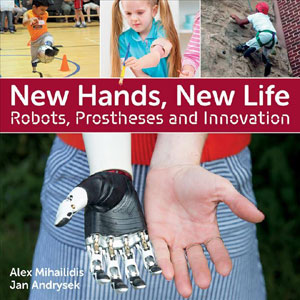| ________________
CM . . .
. Volume XXIV Number 7. . . .October 20, 2017

 |
New Hands, New Life: Robots, Prostheses and Innovation.
Alex Mihailidis & Jan Andrysek.
Richmond Hill, ON: Firefly Books, 2017.
64 pp., pbk & hc., $9.95 (pbk.), $18.95 (hc.).
ISBN 978-1-77085-991-3 (pbk.), ISBN 978-1-77085-969-2 (hc.).
Subject Headings:
Prosthetics-Juvenile literature.
Self-help devices for people with disabilities-Juvenile literature.
Grades 4-7 / Ages 9-12.
Review by Gillian Richardson.
***½ /4
|
| |
|

excerpt:
A prosthesis is a replacement for a part of the body that is missing. Sometimes prosthetic limbs are called artificial limbs. Prostheses can be used to improve a person’s appearance or to replace an important function that has been lost. Some prostheses can do both. A prosthetic eyeball, for example, is used only to improve someone’s appearance (since no sight is possible). A prosthetic leg, though, allows a person to walk while also making the leg appear complete.
Types of Prostheses
A prosthesis is usually named after the part of the body it replaces. Lower-limb prostheses refer to the legs, while upper-limb prostheses refer to the arms. A person can have a prosthetic finger or toe, or a full arm or leg. Arm and leg prostheses are much more complicated and difficult to build.
For a young tech-savvy generation, the use of machines in day-to-day life is taken for granted. So the topic of assistive technology that makes it possible for people with disabilities to function more easily is appealing. New Hands, New Life is co-written by a team of scientists researching rehabilitation engineering and ways to use innovative technology in health care. A brief “Introduction” narrows the focus from the kinds of machines that make life easier to those especially designed to assist the disabled and touches on why they are needed. To set the scene, the first chapter, “How We Move”, discusses the functions of bones, muscles and brain, while the second, “When Things go Wrong”, provides a few examples of diseases or injuries that lead to the need for technological aides. Chapter 3 describes those devices and machines. The fourth chapter shows how they are adapted to individual needs. Chapter 5 is all about robots and how they combine with prosthetic devices to advance their effectiveness. A final chapter offers ways young readers can learn more about this field of science. A brief “Glossary” and “Index” complete the book.
The authors have done a good job of presenting a complex topic in simple understandable language, using small chunks of text. The rather long title using what may be a couple of difficult words to some young readers had suggested the book might have a higher level of readability, but that impression vanished on the first page. In the first two chapters, in particular, definitions and explanations are easy to follow and lay a strong foundation to move the reader into the more complicated detail of various prosthetics. Neat historical facts (a prosthetic toe belonging to a mummy!) are given to show the progress of this field of science. Throughout the book, a combination of clear, current photos and crisp, well-labeled drawings support the content. The “Glossary” is less effective; most of the 10 terms listed are adequately defined in context. However, there are several other technical words that could have been included, such as cadaver, pronate, prototype, and mobility technologies.
This informative book will find a receptive audience among youngsters curious about this amazing and rapidly developing field of health care. Understanding the what, why and how of assistive technology may also help to make them more comfortable with encounters they have with an increasing number of people of all ages using these devices. New Hands, New Life offers such a positive and inspiring message about the ways ‘disability’ can be mitigated with innovation for a healthy active life.
Highly Recommended.
Gillian Richardson is a freelance writer living in BC.

© CM Association
CC BY-NC-ND
Hosted by:
University of Manitoba
ISSN 1201-9364
|
This Creative Commons license allows you to download the review and share it with others as long as you credit the CM Association. You cannot change the review in any way or use it commercially.
Commercial use is available through a contract with the CM Association. This Creative Commons license allows publishers whose works are being reviewed to download and share said CM reviews provided you credit the CM Association. |
Next Review | Table of Contents for This Issue - October 20, 2017.
CM Home | Back Issues | Search | CM Archive | Profiles Archive
|
